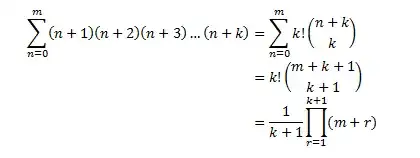Let
$$p_n=\prod_{r=1}^k (n+r)=\overbrace{(n+1)(n+2)\cdots(n+k)}^{k \ \text{terms}}$$
which is the product of $k$ consecutive integers.
Consider the difference of two consecutive terms, where each term is the product of $k+1$ consecutive integers, i.e.
$$\begin{align}
&\prod_{r=1}^{k+1}(n+r)-\prod_{r=0}^k(n+r)\\
&=\overbrace{\underbrace{(n+1)(n+2)\cdots(n+k)}_{p_n}(n+k+1)}^{(k+1) \ \text{terms}}-\overbrace{n\underbrace{(n+1)(n+2)\cdots(n+k)}_{p_n}}^{(k+1) \ \text{terms}}\\
&=p_n[(n+k+1)-n]\\
&=p_n(1+k)
\end{align}$$
Hence,
$$p_n=\prod_{r=1}^k (n+r)=\frac1{1+k}\left[\prod_{r=1}^{k+1} (n+r)-\prod_{r=0}^k (n+r) \right]$$
which is convenient for telescoping.
Required summation,
$$\begin{align}
S=\sum_{n=0}^{m}p_n&=\sum_{n=0}^{m} \prod_{r=1}^{k} (n+r)=\sum_{n=0}^{m}(n+1)(n+2)(n+3)\cdots (n+k)\\
&=\frac1{k+1}\sum_{n=0}^{m} \left[ \prod_{r=1}^{k+1} (n+r)-\prod_{r=0}^{k} (n+r)\right]\\
&=\frac1{k+1}\prod_{r=1}^{k+1} (m+r) \qquad \blacksquare\end{align}$$
by telescoping.
In your example, $k=3$, hence the general term is
$$(n+1)(n+2)(n+3)=\frac14\left[(n+1)(n+2)(n+3)(n+4)-n(n+1)(n+2)(n+3)\right]$$
Hence, by telescoping from $n=0$ to $m$,
$$\begin{align}S&=1\cdot2\cdot3+2\cdot3 \cdot 4+\cdots +(m+1)(m+2)(m+3)\\
&=\frac14(m+1)(m+2)(m+3)(m+4) \end{align}$$
NB: It is interesting to note that this result bears a striking resemblance to integration.
Compare the standard integral
$$\int_0^m n^k dn=\frac{m^{k+1}}{k+1}$$
to the result of the summation above, which can also be stated as
$$\sum_{n=0}^{m}n^{[k]}=\frac {m^{[k+1]}}{k+1}$$
where $n^{[k]}$ is my adjusted* Pochhammer symbol for rising factorials, defined as
$$n^{[k]}=\prod_{r=1}^{k}(n+r)=(n+1)(n+2)(n+3)\cdots(n+k)$$
The actual Pochhammer symbol for rising factorials, $n^{(k)}$, starts from $n$ itself and not $n+1$, i.e.
$$n^{(k)}=\prod_{r=1}^{k}(n+r-1)=n(n+1)(n+2)\cdots(n+k-1)$$

